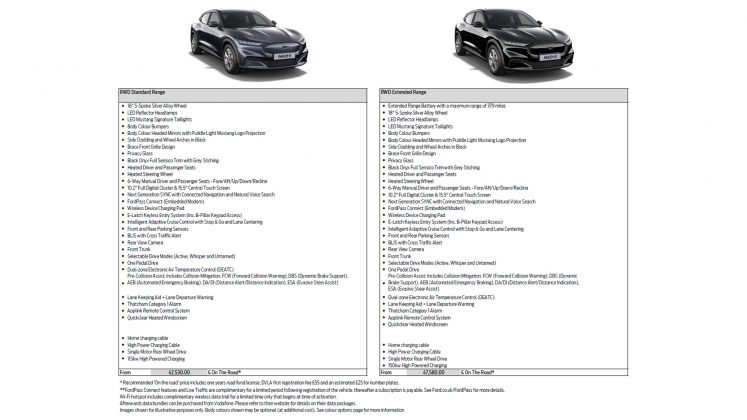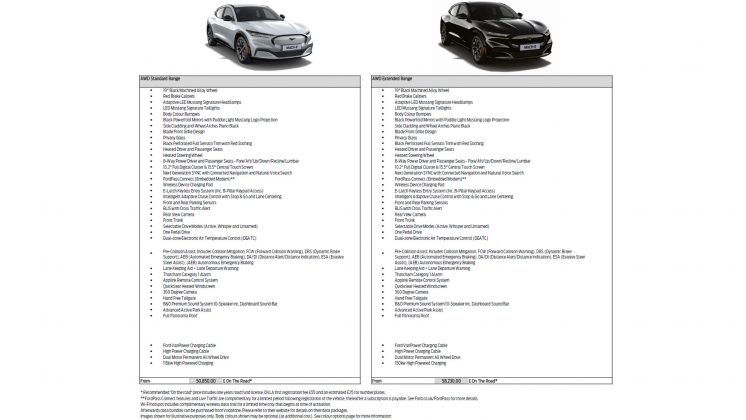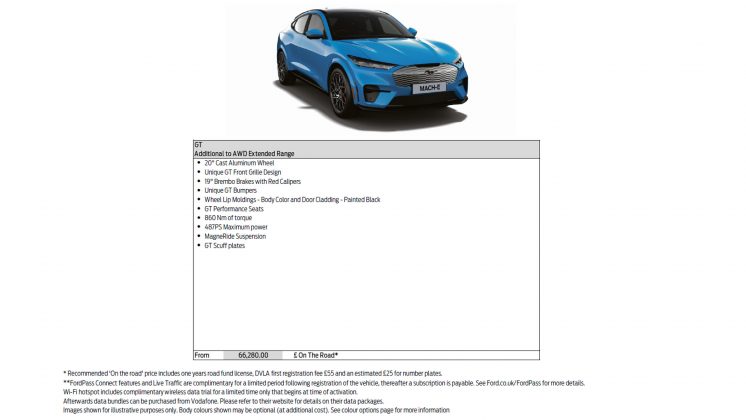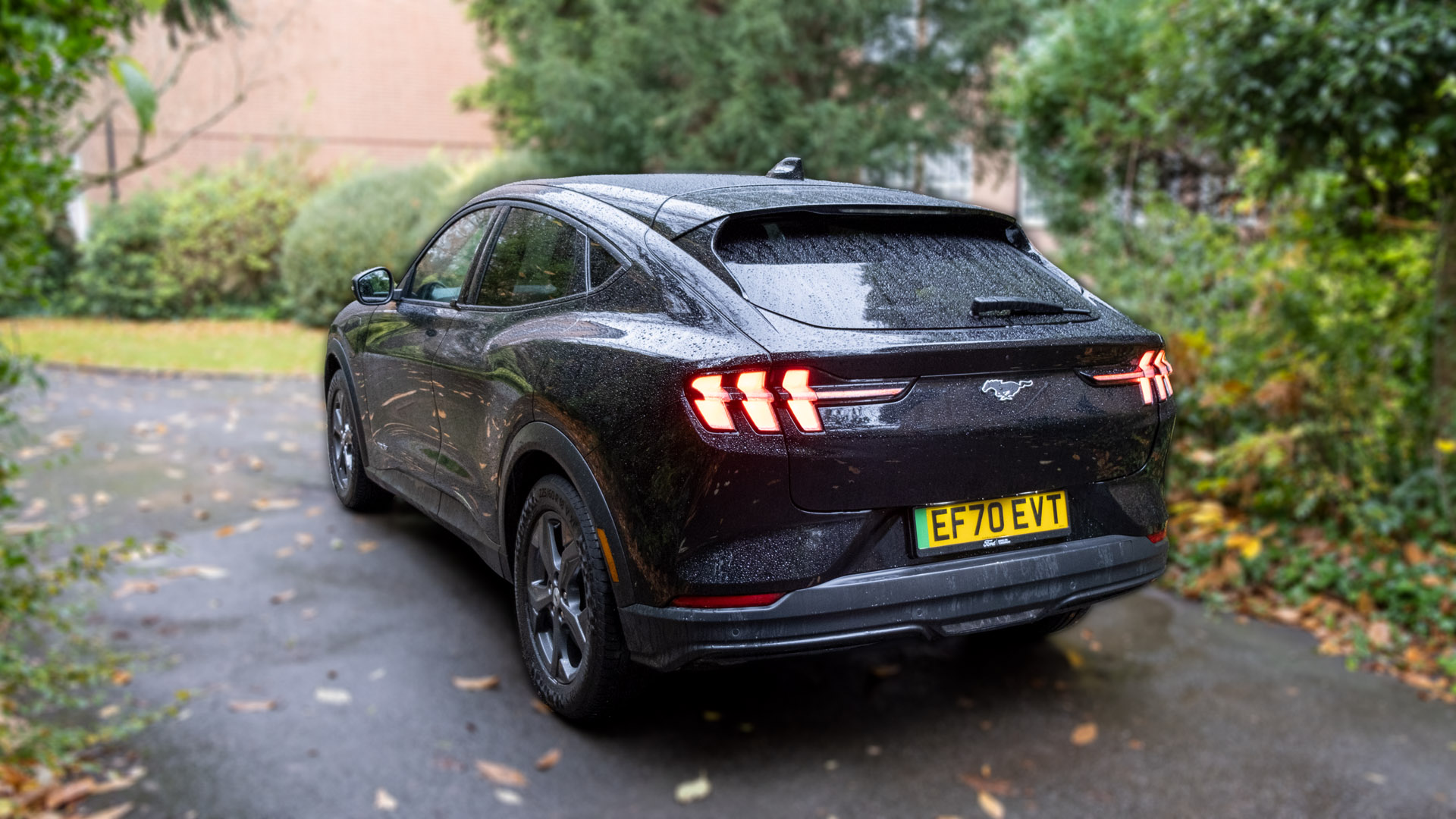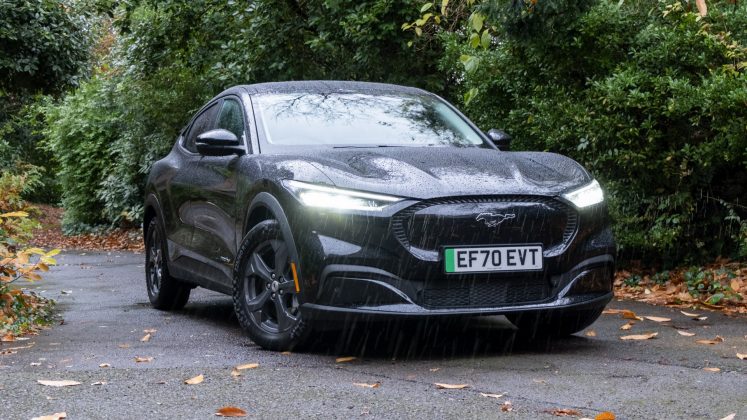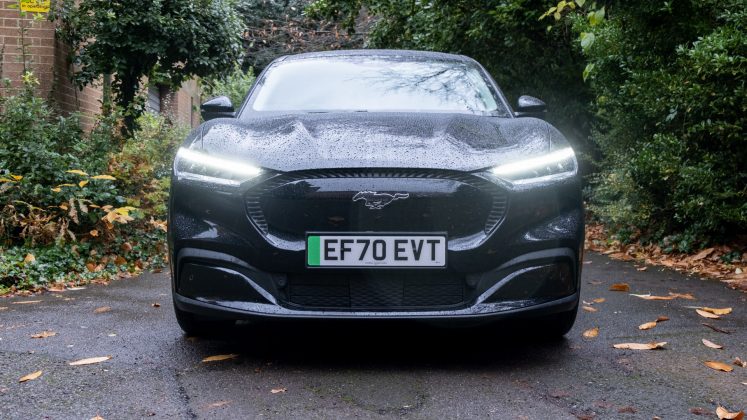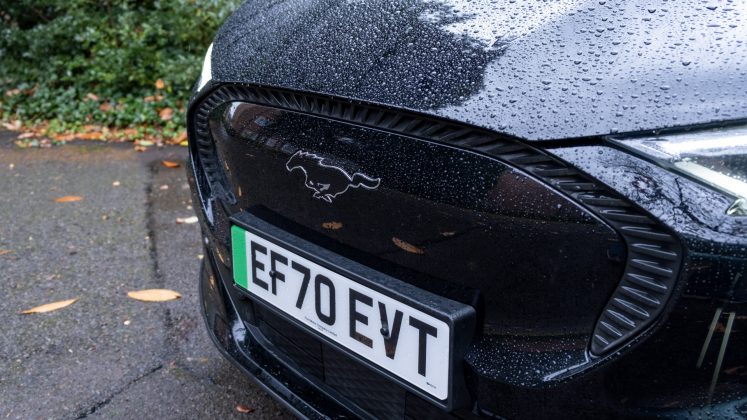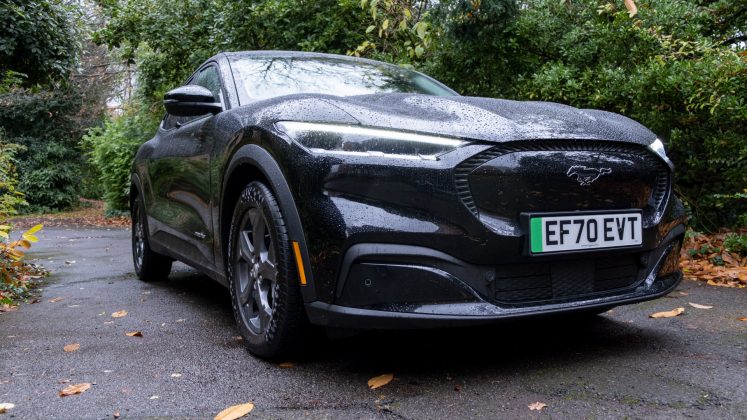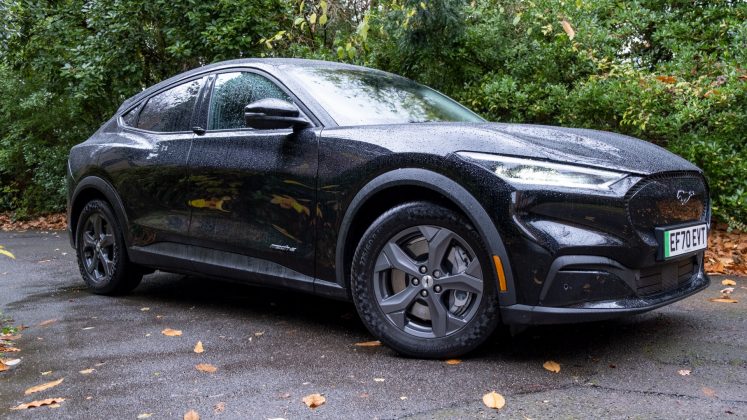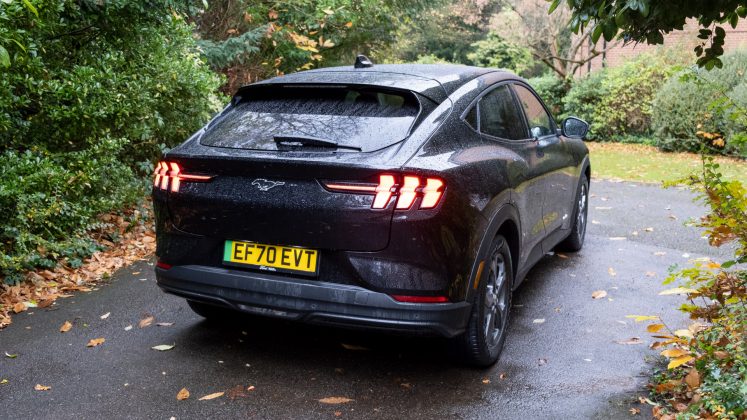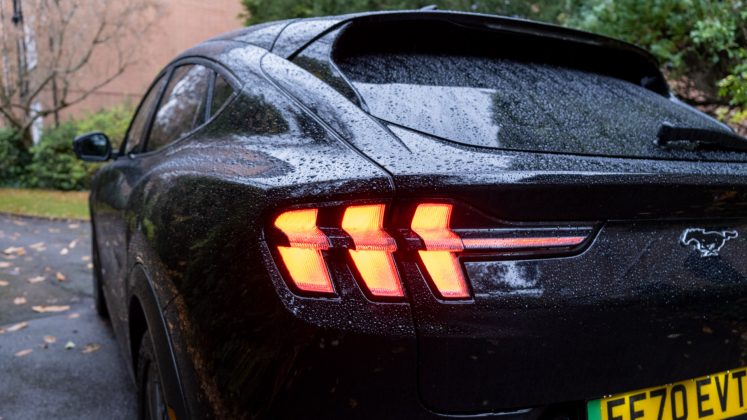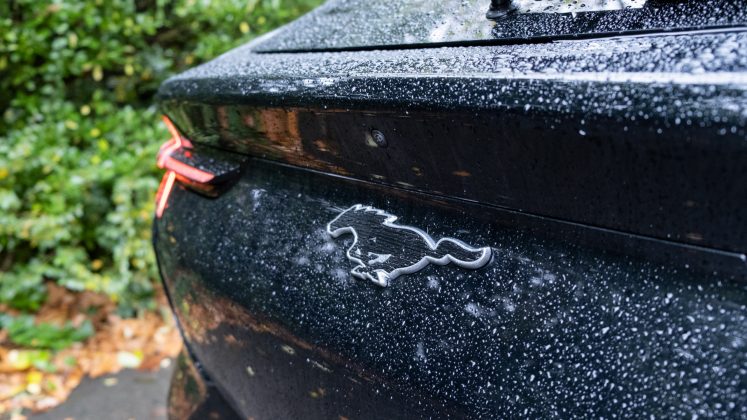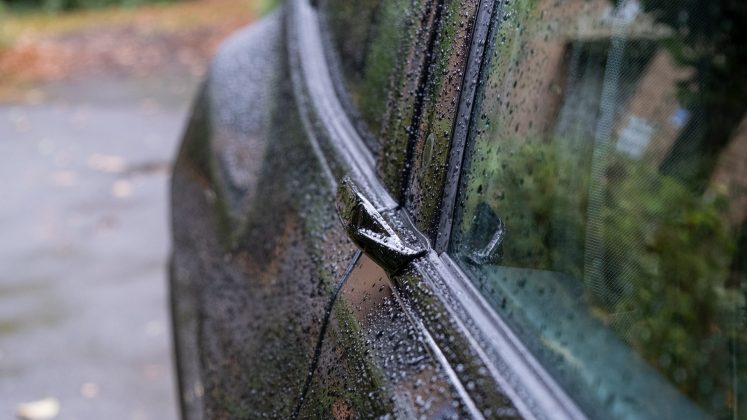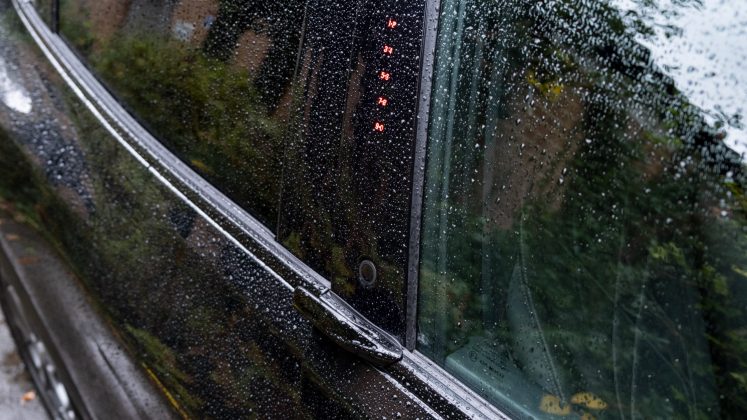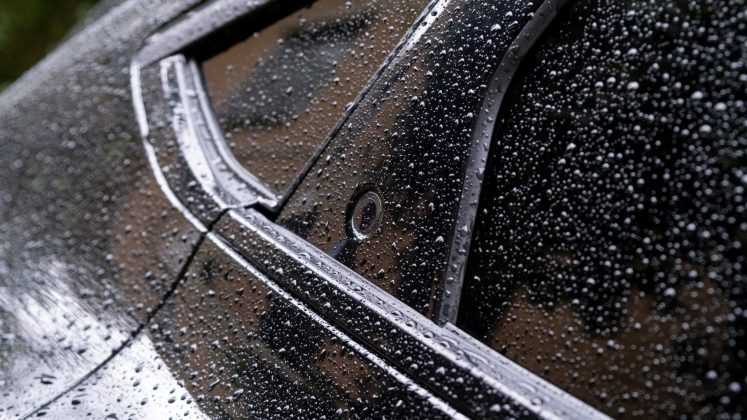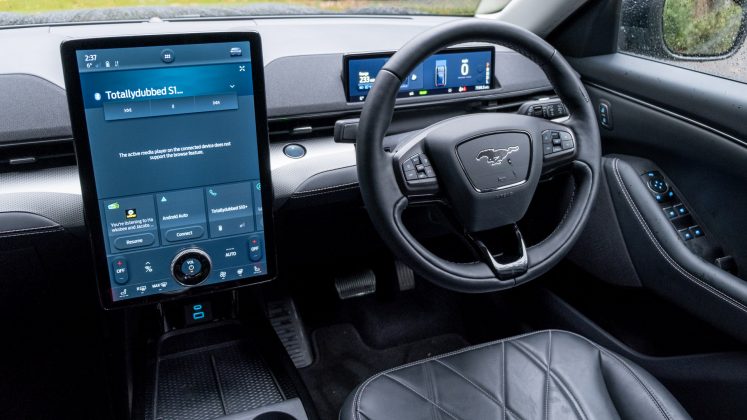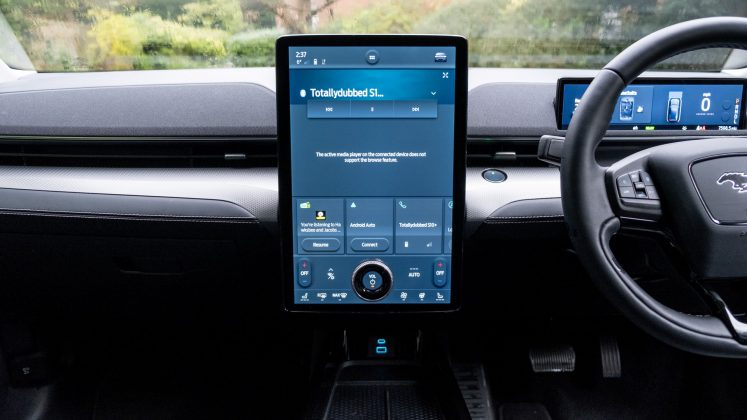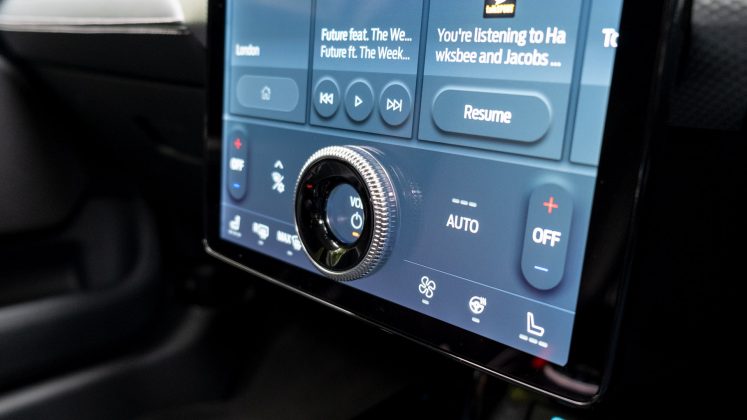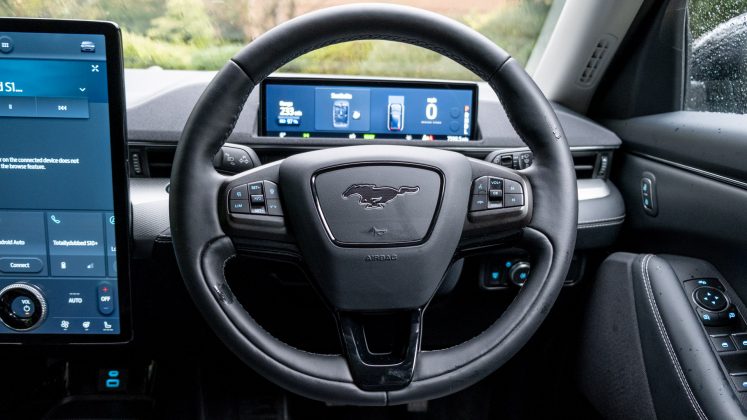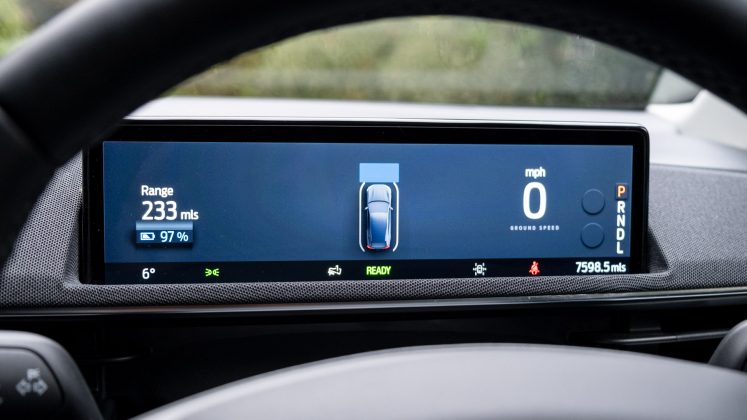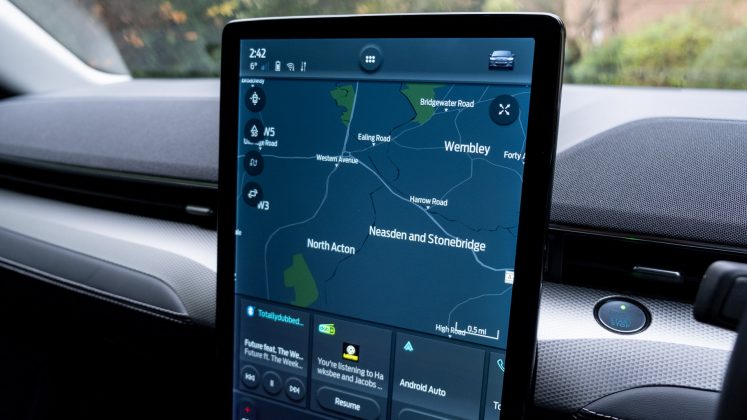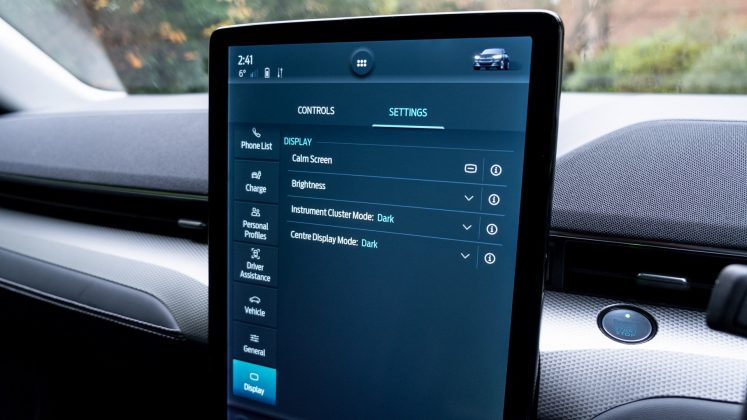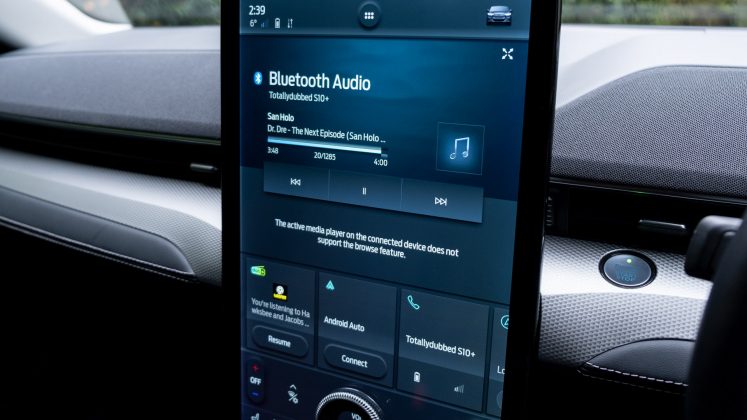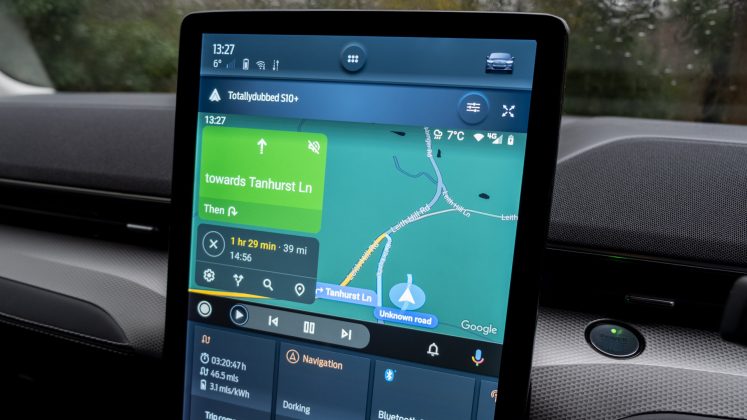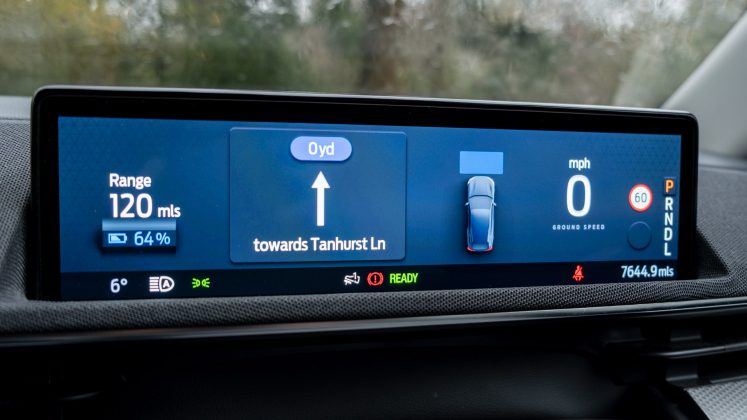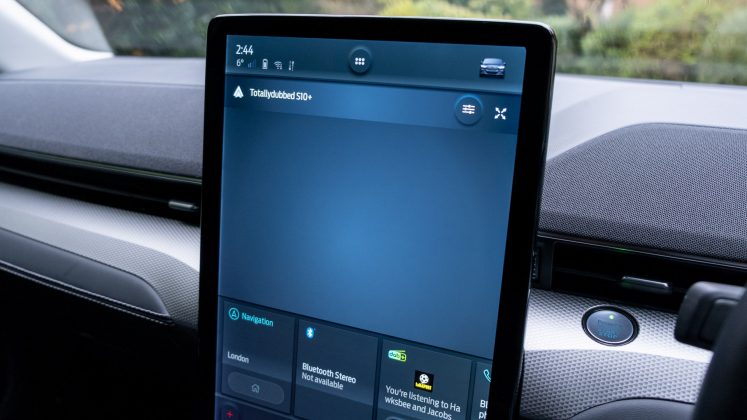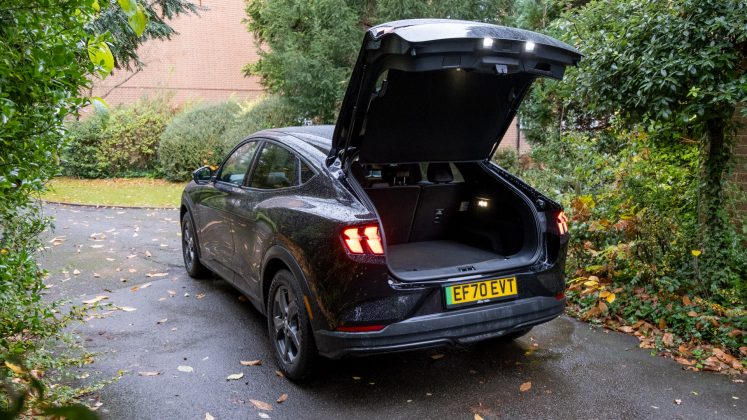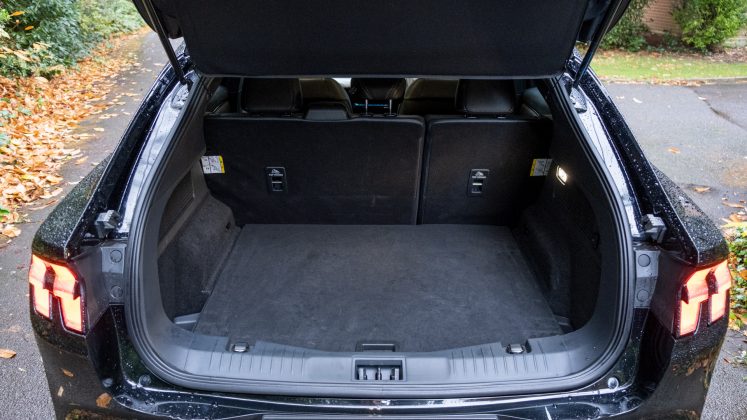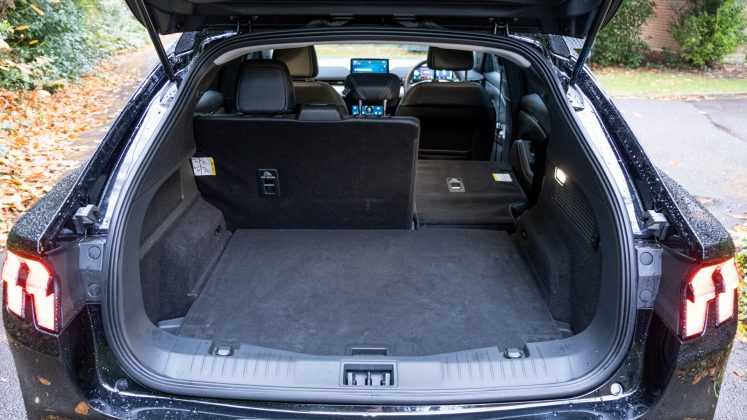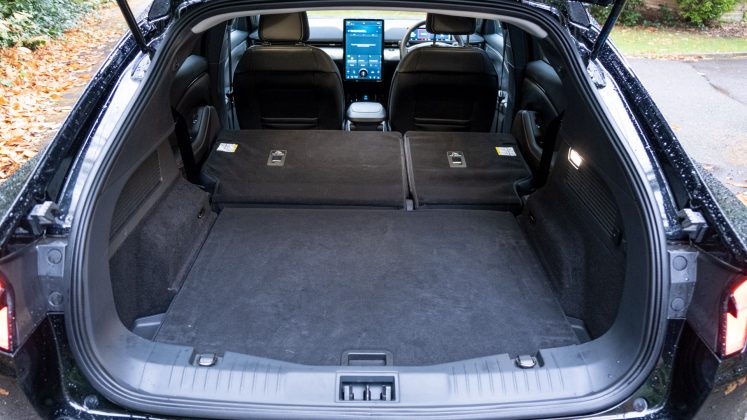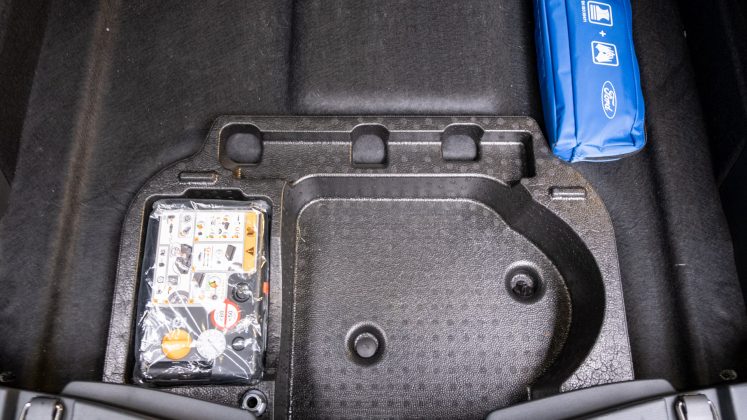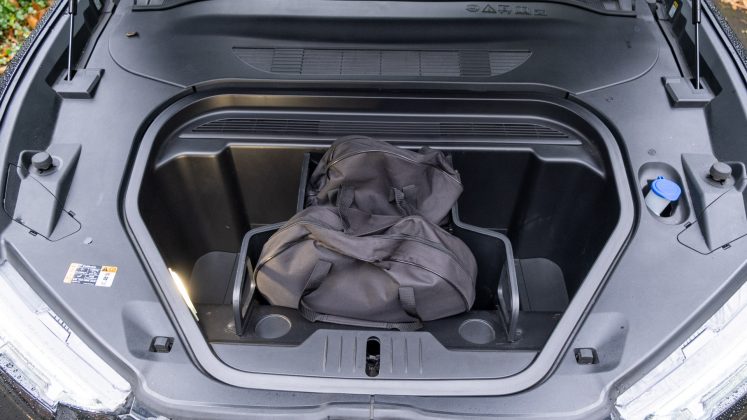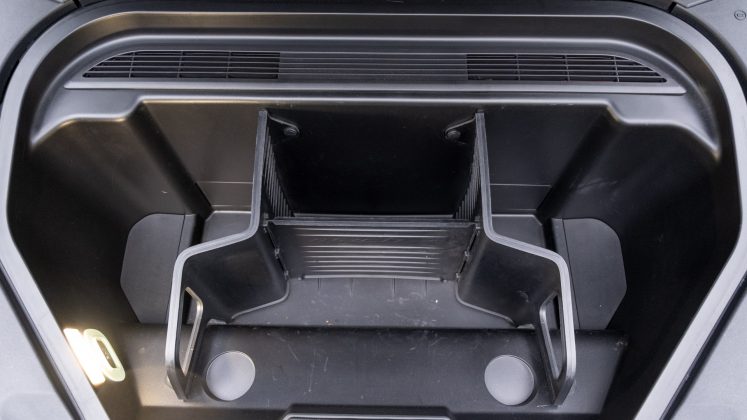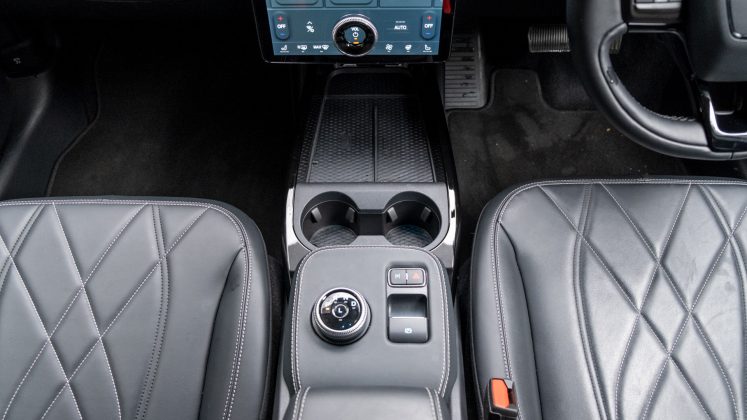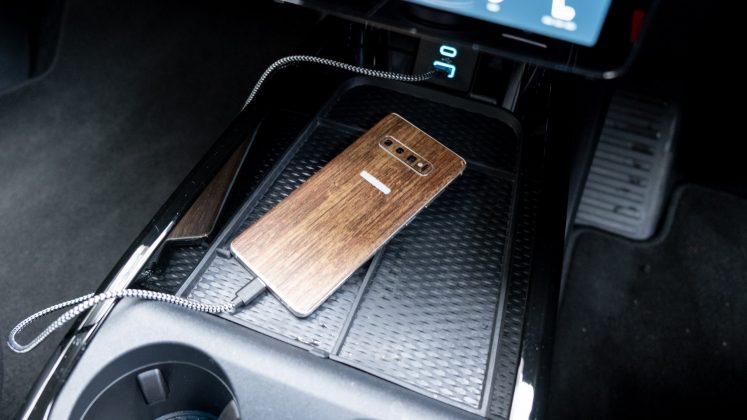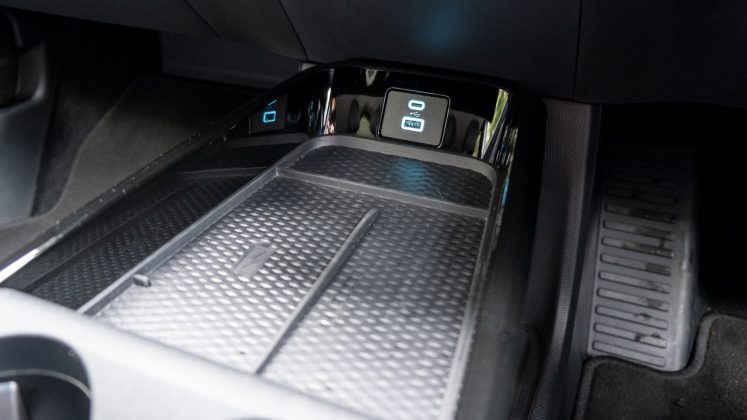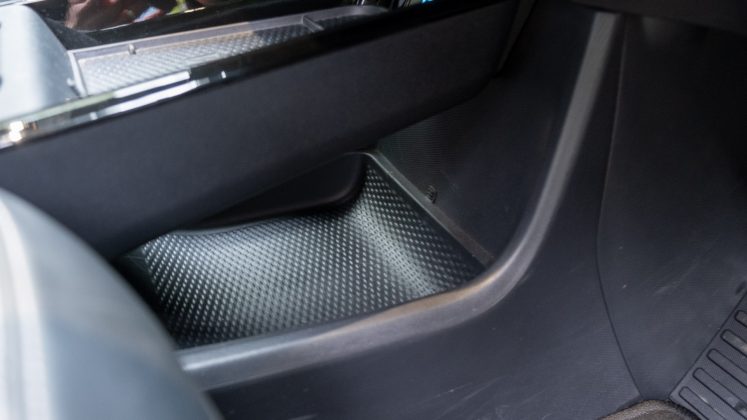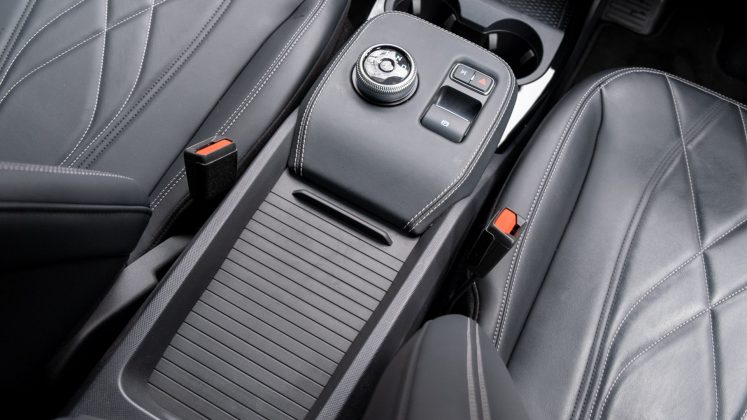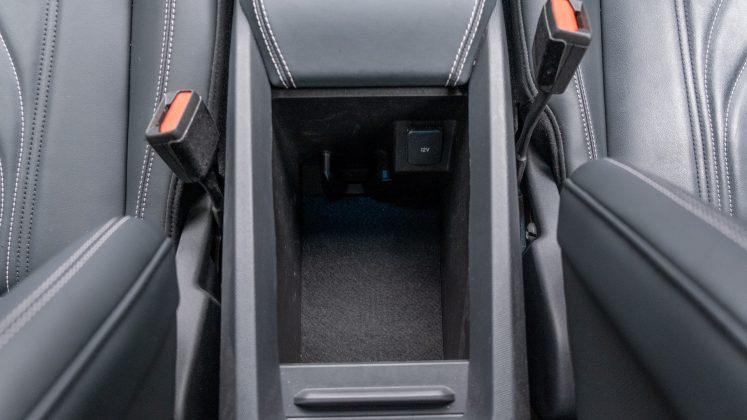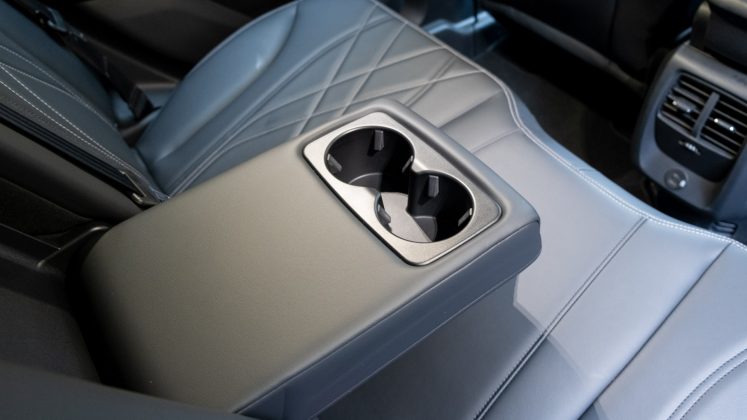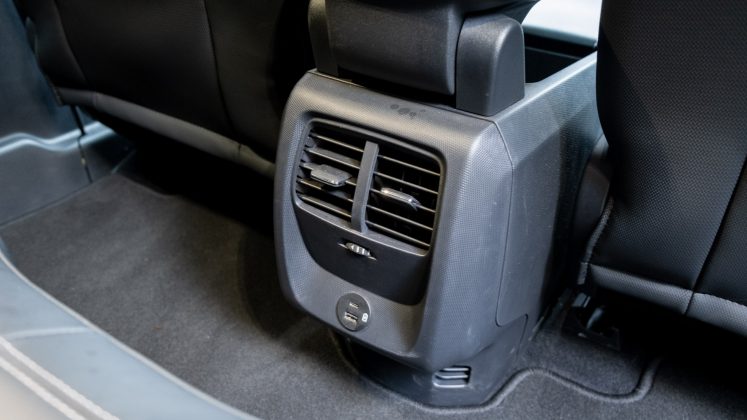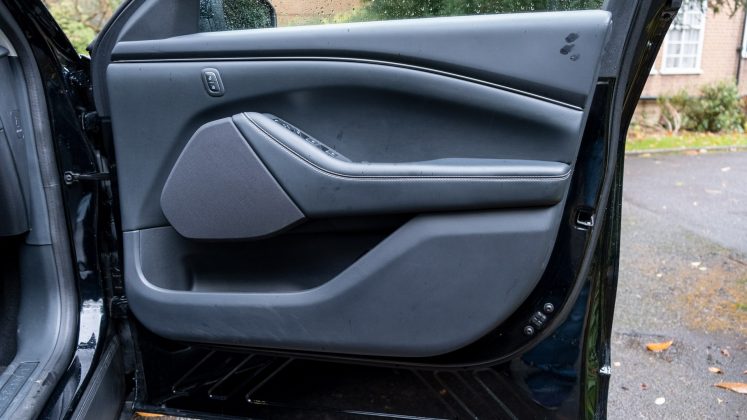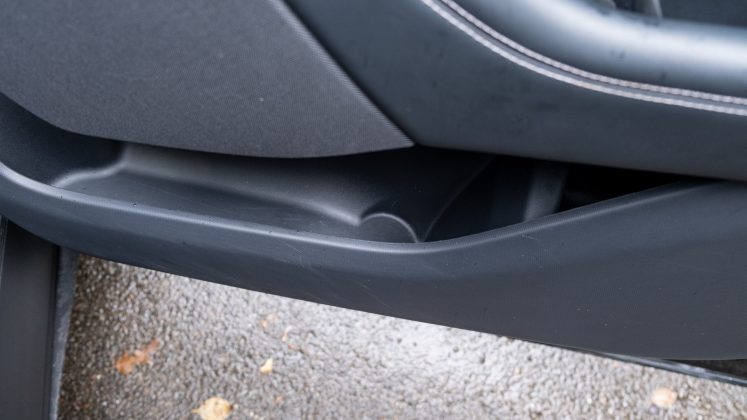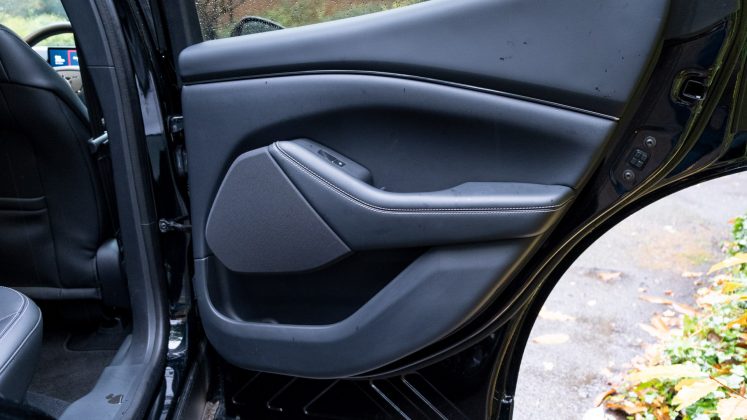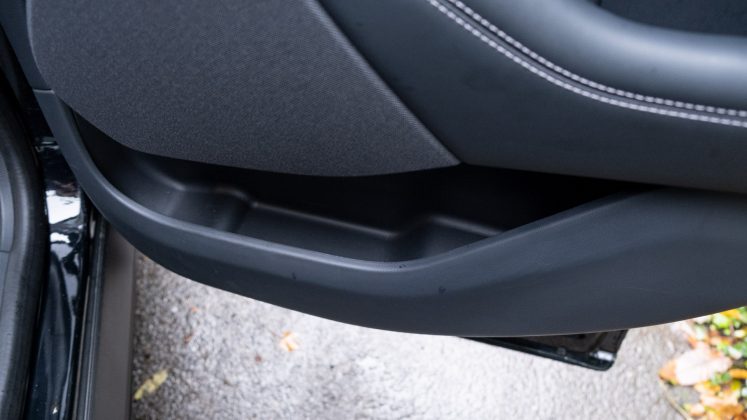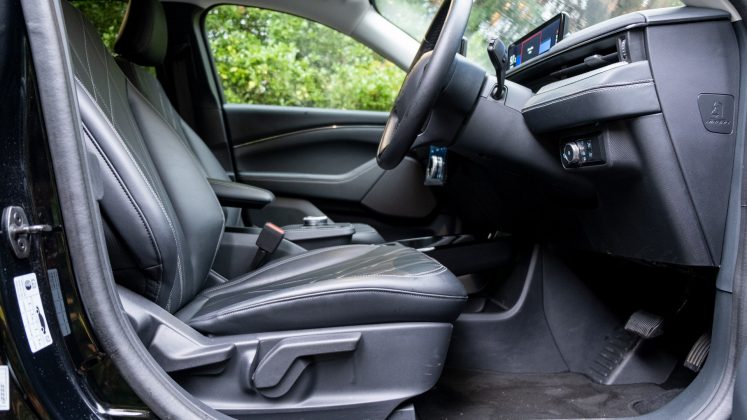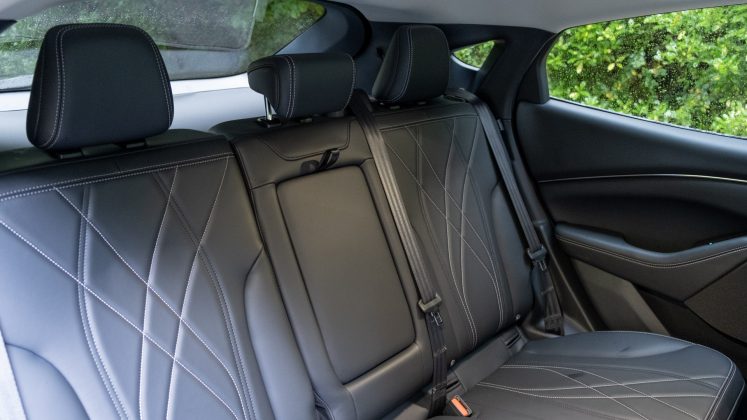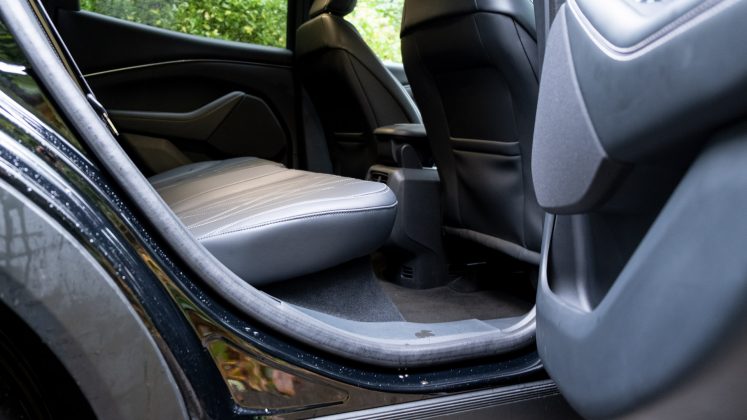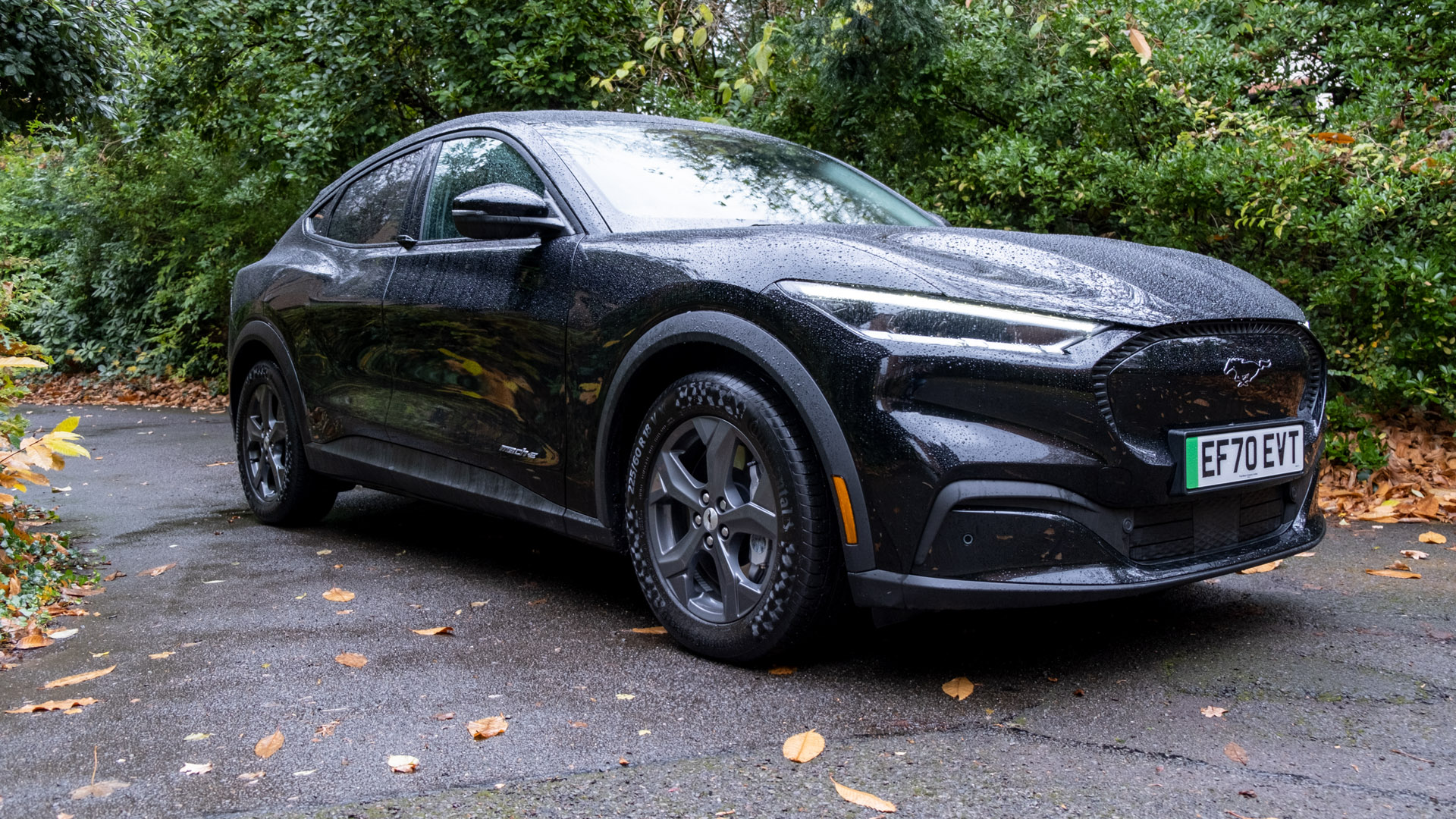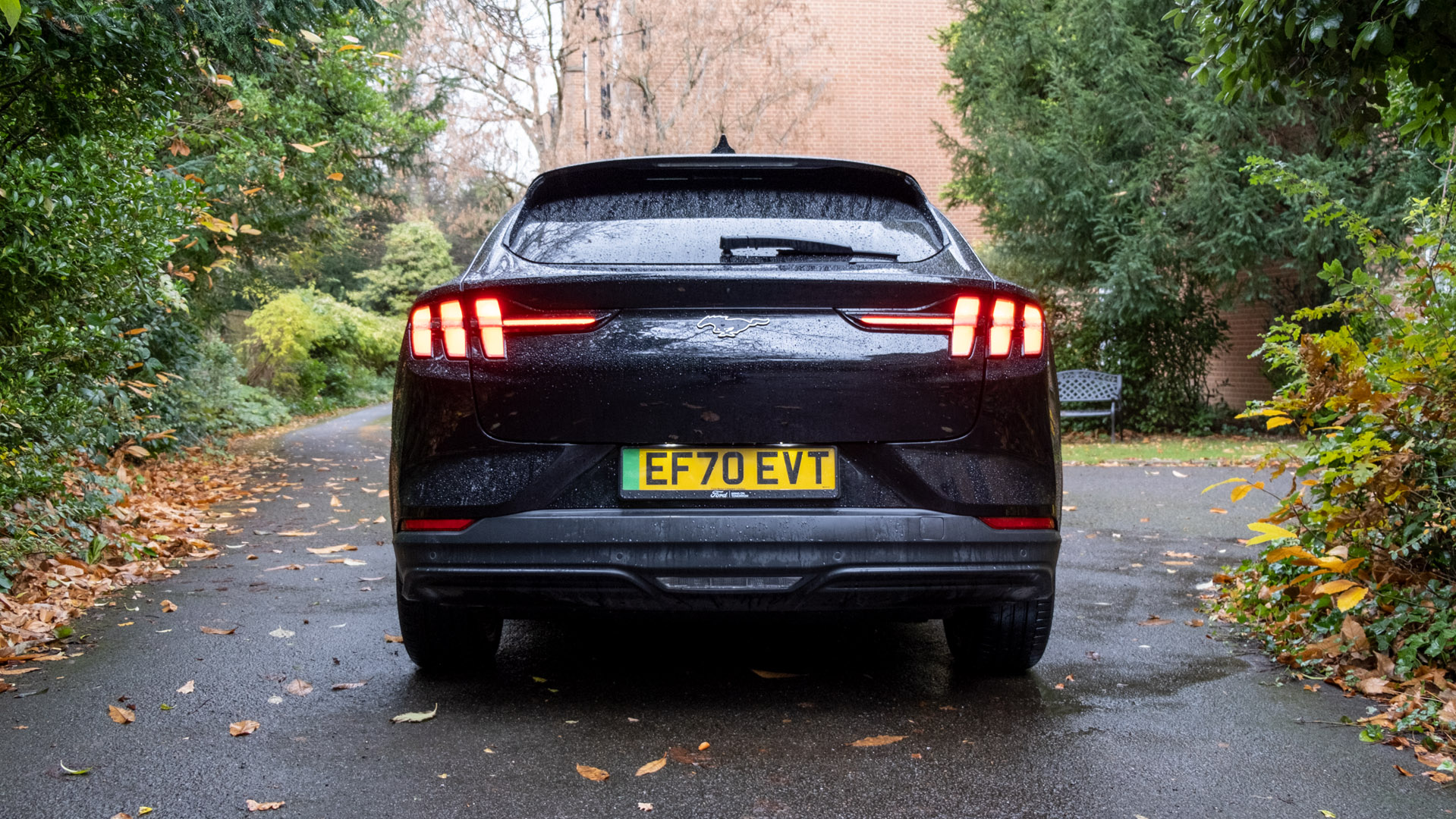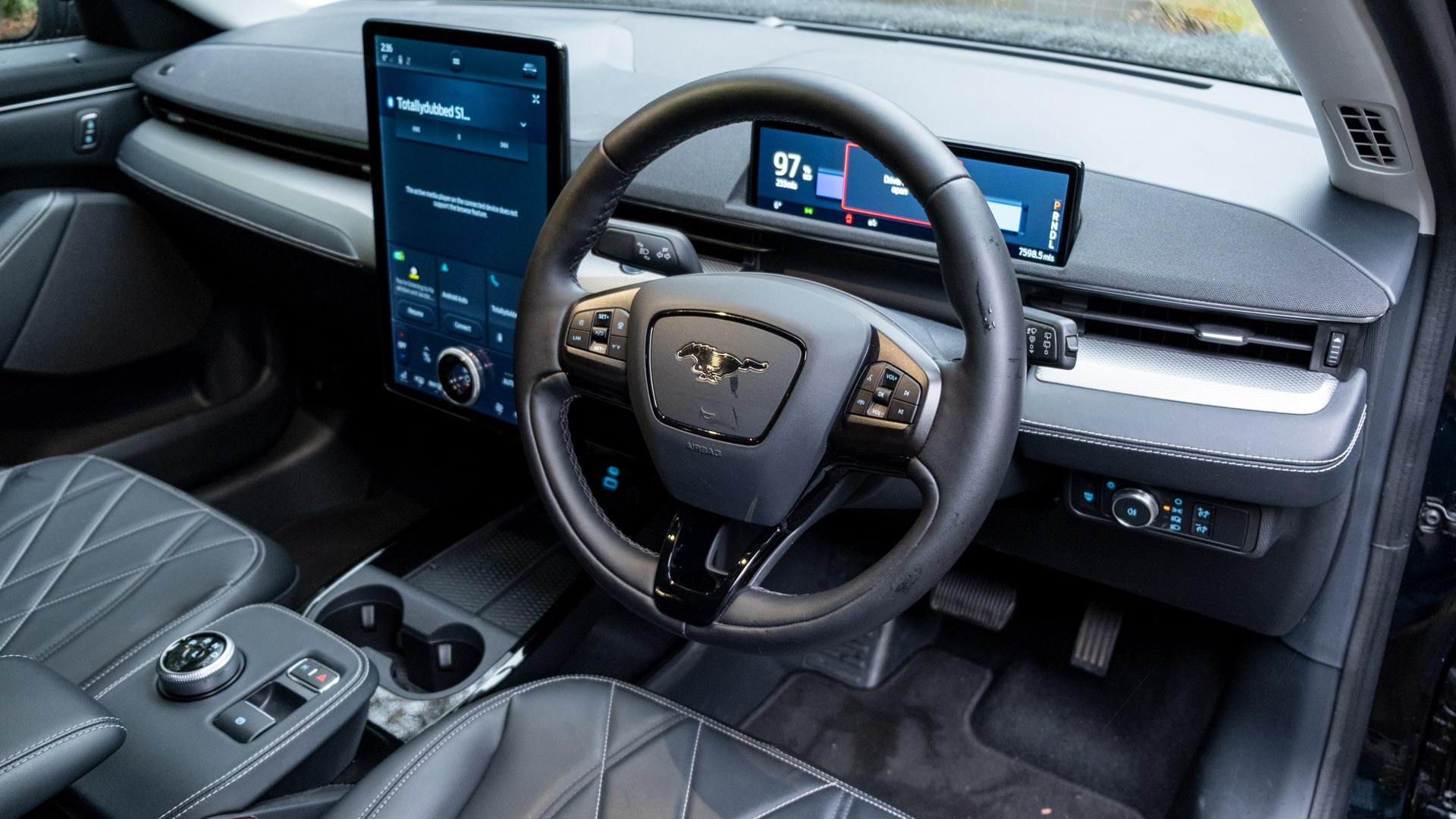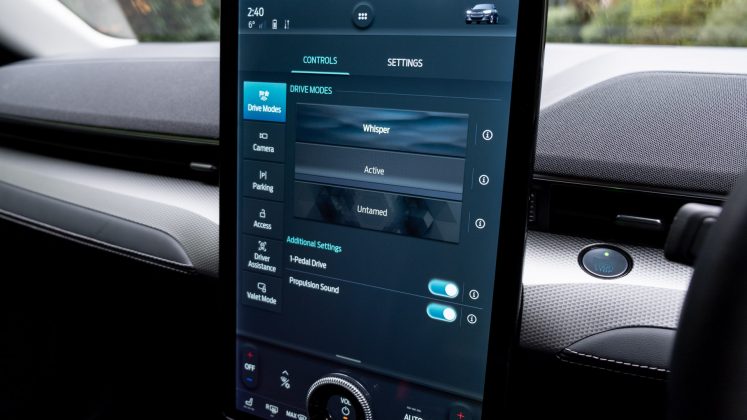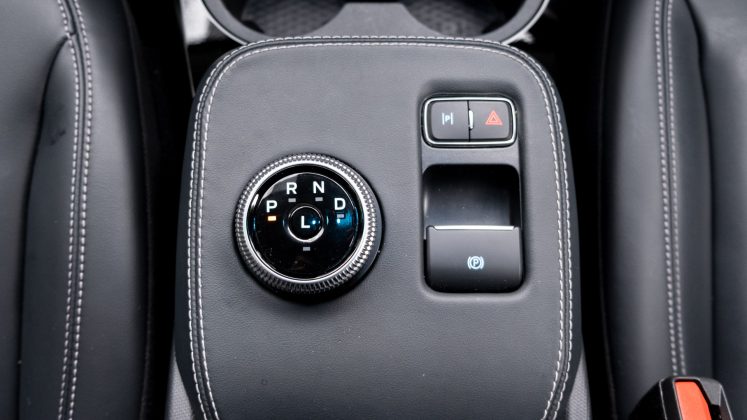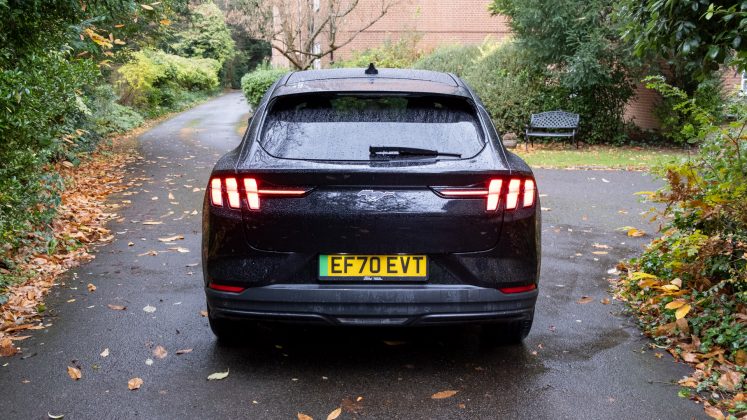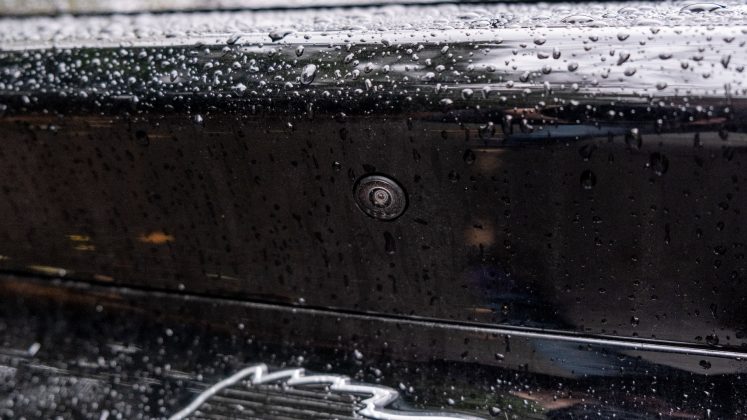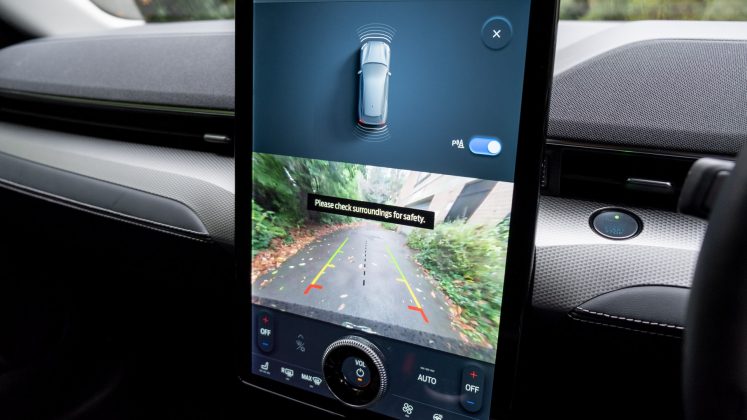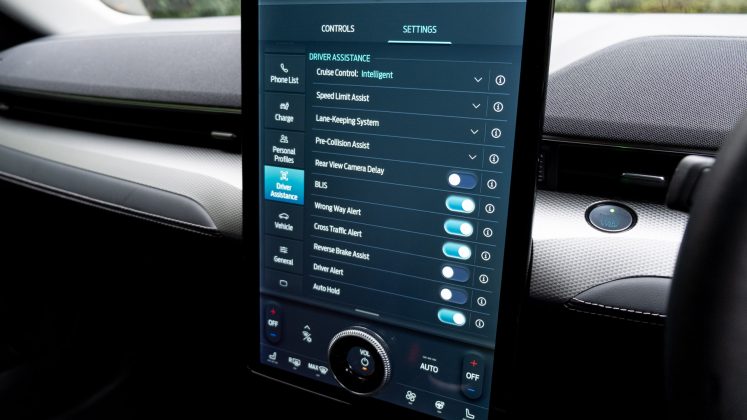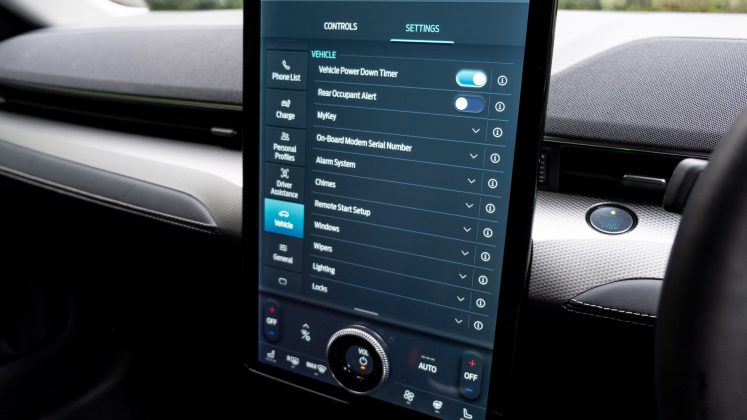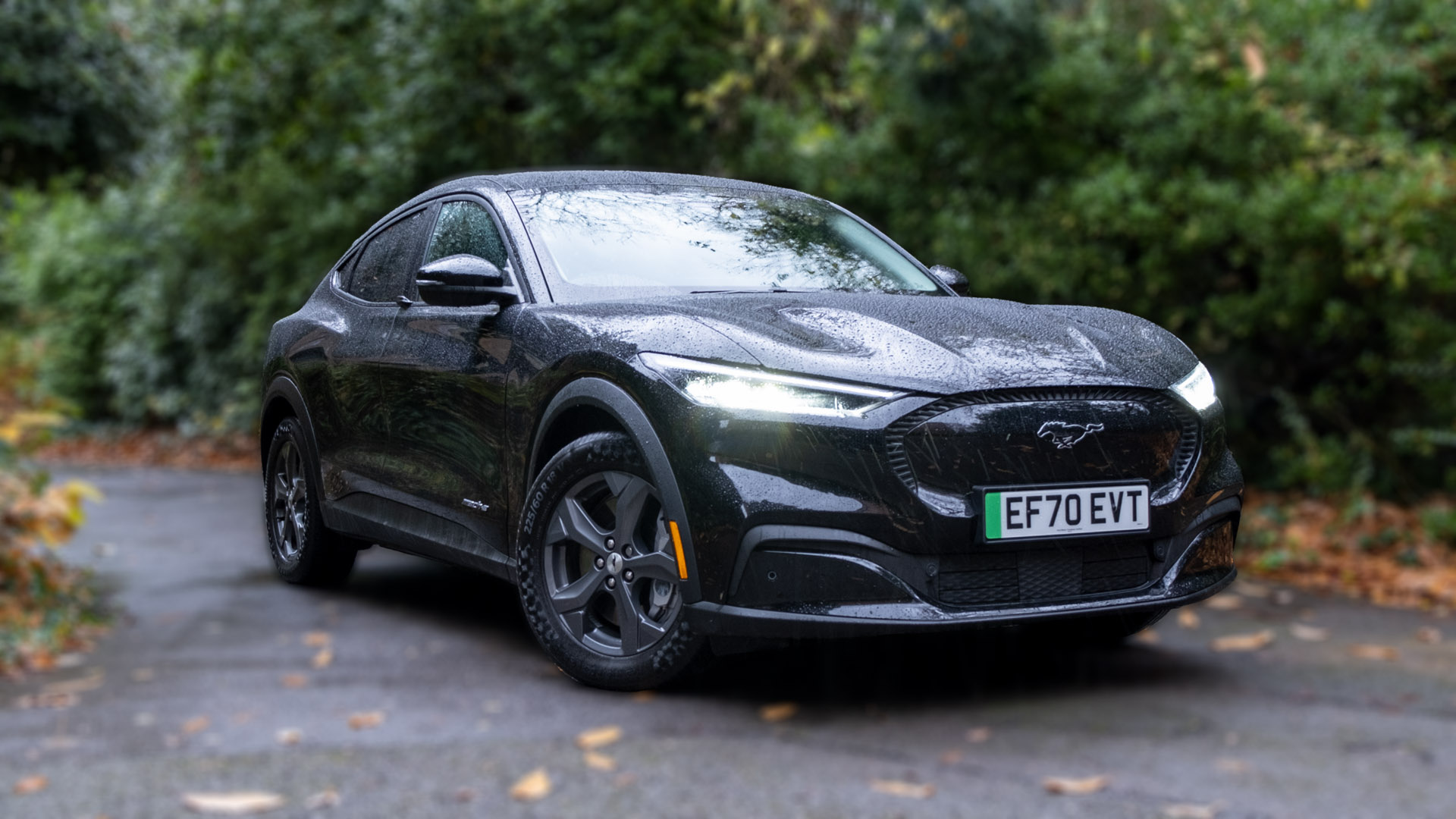In 2019, Ford unveiled its first all-electric vehicle, the Mustang Mach-E. The crossover SUV went on sale in late 2020, marking a new era of electrification for the automaker. Its Mustang nameplate certainly raised a few eyebrows among Ford enthusiasts, as it’s been associated with high-performance petrol-guzzling muscle cars since 1964.
Naming aside, the Mach-E faces stiff competition from the likes of Tesla, Audi, Volvo and the Hyundai Group, among a few others. The question is: can it compete with its rivals or offer something different to the market?
If you’d prefer to watch a review of the Ford Mustang Mach-E, head on over to our YouTube channel.
Ford Mustang Mach-E price & competition
Let’s start with the asking price, as the Mach-E doesn’t come cheap. It starts from £42,530 and extends up to £66,280 for the GT model, before adding options.
It’s available in both a rear-wheel drive (RWD) and all-wheel drive (AWD) configuration, and comes in two battery pack sizes, the 75 kWh (70 kWh usable) ‘Standard Range’ and 98 kWh (91 kWh usable) ‘Extended Range’. A breakdown of the trim levels can be found, below – click to expand:
Find the best Ford Mustang Mach-E deals
When it comes to competition, there are many all-electric SUV and saloon vehicles to consider – in the former, you have: the Hyundai Ioniq 5 from £36,995 (238 miles WLTP); the Mercedes EQA 250 from £44,495 (263 miles WLTP); the Audi Q4 40 e-tron at £44,990 (316 miles WLTP); the Volvo XC40 Recharge Twin at £49,950 (259 miles WLTP); the BMW iX3 from £59,730 (285 miles WLTP); the larger Audi e-tron at £62,025 (227-271 miles WLTP); the Jaguar I-Pace at £65,245 (292 miles WLTP); the Mercedes EQC at £65,720 (255 miles WLTP); and the Tesla Model X at £102,980 (348 miles WLTP).
Elsewhere, there are other SUVs one might want to consider: the MG ZS EV starts from £28,495 (273 miles WLTP); the Kia Soul EV, e-Niro ‘2 64’ and the Hyundai Kona Electric Premium 64 kWh (282 miles WLTP) all come in at £32,445; the Skoda Enyaq iV 60 (256 miles WLTP) from £32,010; the Volkswagen ID.4 from £32,495 (213 miles WLTP); and you’ve also got the MG5 EV, an all-electric estate with a claimed range of 250 miles WLTP that starts from £27,945.
As for saloons and hatchbacks, there are a plethora of options, too: the sporty-looking Polestar 2 starts from £39,990, the efficient Tesla Model 3 from £42,990; the well-rounded VW ID.3 from £30,935; the practical Hyundai Ioniq Electric from £30,550; the Renault Zoe from £27,495; and the comfy Nissan Leaf from £25,995.
Read next: Volvo XC40 Recharge Twin review: A powerful luxury electric SUV
Ford Mustang Mach-E exterior review
From the exterior, the Mach-E lives up to its Mustang branding, at least from the front and rear. Indeed, its frontal profile has an aggressive muscle car look, which is thanks to the vehicle’s flared bonnet and angry-looking LED headlights. Likewise, at the back, it remains on-brand with stylish taillights and a spoiler.
The same, however, couldn’t be said about its side profile as in our opinion, it looks less sporty and is a tad unattractive due to the inclusion of plastic wheel arches. It’s only in the top-spec GT trim, where the surrounding wheel trims become body-coloured; we’d have liked to see this filter down to the ‘cheaper’ models, too.
As with many other new cars on the market, Ford has had the opportunity to tweak certain aspects of the vehicle’s design. Here, the manufacturer has opted for door release buttons on both the front and rear of the Mustang Mach-E. It’s rather intuitive to operate, where a single press will release the mechanism.
At the front, there are also two sleek door handles that make it easy to access the cabin, while at the rear you’ll have to plant your fingers between the door and the vehicle’s frame – one might think it’s unsafe, namely for young adults but thankfully, Ford has implemented a system that prevents the door from slamming shut on your fingers when they’ve just been opened.
When it comes to the exterior finish, it comes in ‘Absolute Black’ as standard, and ‘Space White’ for £800. Should you want ‘Star White’, ‘Dark Matter Grey’, ‘Iced Blue Silver, ‘Grabber Blue’, ‘Cyber Orange’ or ‘Rapid Red’, you’ll need to fork out an additional £1,150.
Read next: Volkswagen ID.4 review: Better than the VW ID.3?
Ford Mustang Mach-E interior review
Moving onto the interior of the cabin, it’s clear to us, that Ford has tried to adopt a familiar look and feel in its choice of materials, while also implementing technology through the large vertically-planted 15.5″ infotainment system and fully digitalized 10.2″ instrument cluster. Indeed, while there are a select number of physical buttons and dials namely within the driver’s view, the main centre-weighted display is your one-stop shop to tinker with the vehicle’s settings – this, unfortunately, includes the climate controls too.
Surprisingly, the physical rotary dial placed towards the bottom of the 15.5″ display is only used to adjust the media volume. Pressing it won’t access a secondary function and nor can it be customised. A missed opportunity by Ford, at least in our opinion.
As for the display itself, it’s vivid, has settings that are smartly laid out and the system can be used in both dark or white mode. It also supports wired and wireless Android Auto and Apple CarPlay, wherewith the former, turn-based navigation data also feeds into the instrument cluster. However, there’s no Head-Up Display (HUD) fitted as standard in any of the trim levels nor available as an option – a similar complaint we had of the Tesla Model 3.
On the subject of technology, we did experience a few glitches with the infotainment system. For example, when plugged in via USB, Android Auto would sometimes refuse to load altogether. When it would work, however, disconnecting from the vehicle’s system, would result in Google Maps staying frozen on the screen for a few minutes; something we’ve not experienced before on other vehicles, and while we could be an anomaly it still hindered our in-cabin experience.
Similarly, another area that might not concern everyone is one’s view of the 10.2″ instrument cluster. Due to its horizontal design, the top segments of the display are concealed behind the steering wheel, which means certain information can’t be easily seen while driving; further cementing our comments about the omission of a HUD.
Elsewhere, the Mustang Mach-E has a stock four-speaker audio setup; at least, from what we could hear when sat within the cabin – Ford has yet to confirm the number of audio drivers present inside its vehicle but once we get official confirmation we’ll be sure to update this review. Nevertheless, its stock speaker configuration is lacklustre in performance and fails to provide any sort of competition to the likes of the Tesla Model 3, Polestar 2, Volvo XC40 Recharge Twin Pro or the Kia Soul EV among just a few fantastic-sounding stock systems. If you’d like to hear how the stock system sounds, watch our detailed review on YouTube.
Thankfully, one can upgrade to the 10-speaker B&O audio system that outputs 560 Watts. It’s comprised within the £3,600 Tech Pack, which also includes 360-degree cameras, an electric tailgate, Advanced Active Park Assist and a panoramic glass roof. Note, despite the GT model operating on an AWD system, the glass roof is omitted but can be added on for an additional £995.
Ford Mustang Mach-E storage review
Indeed, an electric tailgate isn’t fitted as standard in the regular RWD trims and leaves much to be desired given the asking price of the vehicle. Should you want it fitted, you’ll need to opt for the AWD variants or purchase the Tech Pack.
On the plus side, the Mach-E’s boot capacity is plentiful. There’s 402 litres and with the seats propped down, this figure goes up to 1,420 litres. Put it into perspective, here’s how it stacks up to its all-electric rivals: the Audi e-tron (660/1,725 litres); Skoda Enyaq iV (585/1,710 litres); VW ID.4 (543/1,575 litres); Hyundai Ioniq 5 (520/1,587 litres); BMW iX3 (520/1,560 litres); Audi Q4 e-tron (520/1,490 litres); MG5 EV estate (464/1,456 litres); Kia e-Niro (451/1,405 litres); Peugeot e-2008 (434/1,467 litres); MG ZS EV (448/1,375 litres); Volvo XC40 Recharge Twin Pro (452/1,328 litres); Kia Soul EV (315/1,339 litres); Mercedes EQA (340/1,320 litres); Citroen e-C4 (380/1,250 litres); Nissan Leaf (435/1,161 litres); Hyundai Ioniq Electric (357/1,417 litres); Tesla Model 3 (425/1,235 litres); VW ID.3 (385/1,267 litres); Renault Zoe (338/1,225 litres); Polestar 2 (405/1,095 litres); Mazda MX-30 (341/1,146 litres); Hyundai Kona Electric (332/1,114 litres).
Much like a few of its rivals the Ford has a flat loading bay and has a convenient underfloor storage compartment that allows you to store your cables. The fabric boot load cover is also a nice touch, where it can easily be stored within said area. A few fixing points and a 12V socket also provide extra practicality. A small note, however, the rear seats don’t have a 20:40:20 split-folding design, which means rear occupants might feel a bit more cramped when you’re transporting elongated goods.
Given the Mach-E is designed from the ground up as an electric vehicle, there’s also a compartment at the front – also referred to as ‘frunk’. Indeed, there’s 81 litres of additional storage, which is plenty large for a few shopping bags or your charging cables. It is, however, not as convenient to access, whereby you’ll need to release the frunk as you would on an ICE vehicle; it’s not electronically operated nor has Ford integrated a release button on the infotainment system. Furthermore, it requires a substantial amount of force to slam shut.
Moving inside the cabin, there’s a sufficient amount of storage space. At the rear, there are two cupholders found within the rear armrest and some storage space within the door bins. At the front of the cabin, there’s a convenient non-slip area to store and wirelessly charge a smartphone; here there’s also a USB Type-A and Type-C ports for wired connectivity. Under this area, you’ll also find another non-slip compartment. Further down the centre console, there are two cupholders and an area under the front armrest for larger-sized valuables. Above, there’s also a handy area to store sunglasses.
Elsewhere, the glove compartment and front door bins are large enough for a small-to-medium-sized purse or wallet. Unfortunately, the latter isn’t appropriately designed for 500ml bottles, where they’ll move around when driving.
Read next: Skoda Enyaq iV review: The Volkswagen ID.4 alternative
Ford Mustang Mach-E comfort review
Onto comfort, the electric Mustang seats up to five occupants. The rear middle seat is unsurprisingly a little stiff, but due to the vehicle not having a transmission tunnel it means all rear occupants can place their feet flat on the ground. As for headroom and legroom, at the rear of the cabin 6-foot 4-inches (193cm) individuals might feel a little henned in, while those who are a little shorter won’t have the slightest problem.
At the front, six-way manually-adjustable seats allow for a certain degree of adjustment, while electronically-adjustable seats come as standard in the AWD models. For extra comfort, Ford has included a heated windshield, steering wheel and front seats in all trim levels – the former being particularly handy in cold weather conditions.
As for cabin noise, the Mustang Mach-E does suffer from a bit of tyre noise at the front of the cabin and has a bit of audible wind noise deflecting off the A-pillars; it’s not as silent as some of its main rivals.
Read next: Tesla Model 3 review (2021 facelift): Should you buy into the hype?
Ford Mustang Mach-E performance review
The biggest annoyance, however, comes in form of its stock suspension setup. It’s overly stiff, can’t be customised and results in one of the most uncomfortable experiences we’ve ever come across in testing an electric vehicle; potholes and speed bumps can be felt, while traversing uneven terrain for a prolonged amount of time will result in some lower back pain. Should you want the ‘MagneRide’ adaptive suspension system, you’ll need to opt for the GT model – at the time of writing, there’s no means of adding the option to the other trim levels.
Find the best Ford Mustang Mach-E deals
Given its stiff configuration, it should come as no surprise that the Mach-E has a minimal amount of body roll when lobbed around windy country roads. This gives you bettered confidence over the likes of the Kia e-Niro, Peugeot e-2008, Renault Zoe and Nissan Leaf, to name just a few of its competitors. But that’s not to be mistaken with the vehicle’s driver’s feel, whereby the Ford lacks that one-to-one input, even when set to its ‘Untamed’ sportier driving mode that stiffens up the steering – ‘Whisper’ mode is the equivalent of Eco, while ‘Active’ is Normal. Indeed, the Mustang Mach-E can’t compete with the likes of the Polestar 2, Tesla Model 3 or VW ID.3, nor the BMW iX3, Volvo XC40 Recharge Twin Pro and Audi Q4 e-tron.
As for raw performance, we had the RWD standard range model tested from 0-60mph in 7.2 seconds. Its rear-mounted motor combined with the 70 kWh battery pack dispatch 198 kW (265 hp) of power and 430 Nm of readily-available torque. Top speed is limited to 111mph. Should you want more, you’ll want to opt for the extended range or AWD models instead, with the GT variant outputting 358 kW (480 hp) of power, a whopping 860 Nm of torque and can achieve up to 150mph.
Buy a car phone mount on Amazon (Affiliate)
So, what about when it comes to the all-important range? Our ‘standard range’ RWD model is equipped with a 75 kWh (70 kWh usable) battery pack, where it’s claimed to run for 273 miles on the WLTP test cycle. Our mixed driving tests, however, yielded only 180-200 miles of range, a rather poor figure given the vehicle’s cell capacity; it shows to us that the Mustang Mach-E isn’t efficient.
Going based on the same driving tests, we attained 230 miles with the VW ID.3, the Hyundai Ioniq 5, the Volvo XC40 Recharge Twin Pro and Polestar 2 (with heat pump) all achieve between 230-250 miles; the Audi Q4 e-tron, the Kia e-Niro, the Kia Soul EV, the Hyundai Kona Electric, and the Volkswagen ID.4 attain 260 miles; the Skoda Enyaq iV nets closer to the 300-mile mark, while the Tesla Model 3 RWD achieves between 230-250 miles, with the Long Range model still reigning supreme at a tested 310 miles.
Of course, one might attain more by opting for one of the ‘extended range’ models, namely the RWD variant that’s claimed to run for 379 miles without stopping. We can only hazard a guess that you’ll attain around 280-300 miles with this particular configuration.
As for one-pedal driving, it can be enabled via the infotainment system or by pressing the ‘L’ button found on the rotary drive selector. The two are near-identical, where one won’t result in harsher regenerative braking but according to Ford, the latter mode is preferred when going downhill. Here, ‘L’ mode isn’t retained when switching on the vehicle from fresh but toggling ‘1-Pedal Drive’ via the infotainment system is indeed retained.
On the subject of customisation, there’s no means of altering the harshness. Most of its competitors have settings through the infotainment system or use flappy paddles to shift between the modes; alas, that’s not the case with the Mustang Mach-E – it’s either on, thus allowing you to come to a complete standstill when you lift off the accelerator pedal, or disabled, which is the equivalent of coasting on an ICE vehicle.
In order to recharge the vehicle, Ford supports up to 150 kW in its ‘extended range’ models, allowing you to go from 10-80% using a DC rapid charger in 45 minutes. The ‘standard range’ model takes just 38 minutes, despite supporting a lower 115 kW input via its CCS port. A more commonly-found 50 kW charger will net you 80% charge in 90 minutes.
Should you opt for a home or workplace charger, the Mustang Mach-E will charge to 80% in 7 hours 20 minutes using a three-phase 11 kW input. It’ll take an additional three hours on a 7 kW charger and over 36 hours on a 3-pin plug socket.
Read next: Hyundai Ioniq 5 review: Better than Tesla Model 3?
Ford Mustang Mach-E safety review
When it comes to safety, the Ford scored 5/5 stars in Euro NCAP’s rigorous crash tests; it managed 92% and 86% in the Adult and Child Occupancy tests, respectively. As for the driver assistance systems, the Mustang Mach-E includes a slew of standardised features: Pre-Collision Assist that includes Collision Mitigation, FCW (Forward Collision Warning), DBS (Dynamic Brake Support), AEB (Automated Emergency Braking), DA/DI (Distance Alert/Distance Indication), and ESA (Evasive Steer Assist); BLIS with Cross Traffic Alert, Intelligent Adaptive Cruise Control with Stop & Go and Lane Centering, Lane Keeping Aid and Lane Departure Warning.
We find adaptive cruise control paired with the lane keeping works faultlessly, as it keeps the vehicle centred and at a safe distance from the leading car; the distance can be customised on the fly via the steering wheel. Should you not want the system enabled – as it’ll be on each time you turn on the vehicle – you can quickly disable it by long-pressing the appropriate button on the steering wheel.
On a more negative note, however, the pre-collision assist was terrible. It would frequently flag danger and thus incorrectly do an emergency stop, causing more danger than good; given the system can’t be permanently disabled, it means you’ll need to disable the appropriate setting on the infotainment system each time you step inside the cabin.
Finally, onto visibility, the Ford Mustang Mach-E is excellent at the front and side, however, the rear becomes limited when it’s raining or muddy as the rearview wiper doesn’t cover the top segment of the window; resulting in limited rearview vision. Thankfully, a rearview camera, front and rear parking sensors all come as standard.
Read next: Polestar 2 review: The all-electric muscle car
TotallyEV’s verdict on the Ford Mustang Mach-E
On the whole, Ford’s first stab at an electric vehicle is commendable. The Mustang Mach-E has stylish exterior aesthetics, a familiar-feeling interior and a spacious boot. However, it fails to deliver in two key areas: performance and range, with the former being a cornerstone of the Mustang brand. It drastically falls short of its competitors in its all-electric driving range and isn’t particularly comfortable to drive either.
Find the best Ford Mustang Mach-E deals
Ultimately, there are other alternatives to consider: the more affordable Hyundai Kona Electric, Kia e-Niro and Kia Soul EV all offer a compelling package should storage space and raw performance not be your utmost priority. If they are, the Volvo XC40 Recharge Twin Pro, Skoda Enyaq iV and Audi Q4 e-tron are all better alternatives. Then, you have the VW ID.3, which is an affordable and fun-sized EV; the Polestar 2 with its driving dynamics, and the Tesla Model 3, which provides class-leading driving range and a fully-fledged charging infrastructure.
Suffice to say, you have plenty of options. Would you pick the Ford Mustang Mach-E over its rivals? Let us know in the comments section below or via social media; we’re on: YouTube, Instagram, Facebook, Twitter and LinkedIn.

